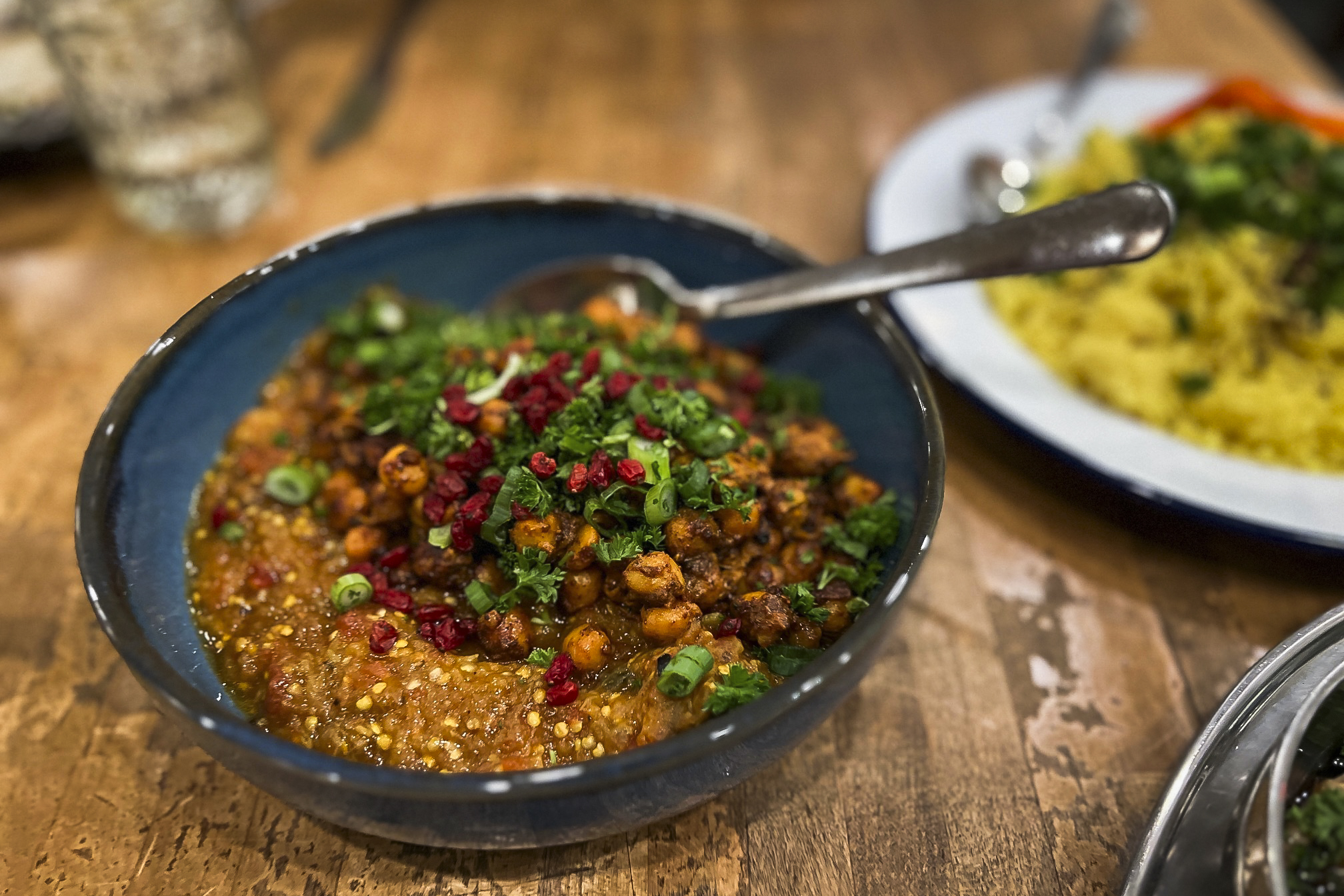Chef Hanif Sadr fuses old-world style with new-world research in his cooking. It’s an approach that makes the expansion of his Iranian restaurant in San Francisco’s Bernal Heights feel both familiar and novel, comforting and unexpected.
Warm wood, earthen jugs and colorful pottery set the tone at Komaaj Mazze Bar on 29th Street, where a loud and lively ambience—and an Iranian grandmother’s answer to soul food—greet a consistently packed house of customers. Sadr, a trained engineer who considers himself more of a researcher than a chef, approaches his dishes with humility.
“I’m a self-taught cook,” he said. “I don’t want to be that kind of chef-y chef-y person.”
Sadr doesn’t want a fancy vibe at Komaaj. Dishes are prepared using the principles of Iranian traditional medicine, which he likens to Indian and Chinese philosophies, with foods that are either “hot” or “cold.” The ultimate goal of any recipe is to balance these two opposites.
Ingredients like yogurt, cheese and pomegranates are cold, whereas nuts and spices are hot. That’s why you’ll see pomegranate-walnut stew, yogurt sprinkled with sumac or dried mint and cheese decorated with nigella seeds.
This approach is perhaps why the recipes at Komaaj feel so healing to eat. They are bright but balanced. You can eat your fill but never feel overfull. “We look at ingredients from a medicinal angle,” Sadr said. “As a treatment for the body or mind.”
The why and the how
Chickpeas are everywhere in Sadr’s cooking, because they support the immune system. Turmeric—the starring spice in the restaurant’s golden-hued, fluffy rice—alleviates pain. Dried barberries, dotted on nearly everything, are full of antioxidants. They also add a colorful splash and are more seasonally available than pomegranates.
The menu is filled with mazzes—the word, which gives the restaurant part of its name, means small dish and also “flavor” in Iranian. There’s the cucumber salad, where the pedestrian salad ingredient is elevated to new heights with the addition of barberries, fava beans and a fermented herb paste dressing. Another mazze, the eggplant and walnut dip, is swirled with pomegranate paste and served with crunchy sangak bread. The marinated olives, typically an afterthought snack on menus, arrive as a hearty portion swimming in tangy pomegranate molasses and sprinkled with Persian hogweed.
The experience of cooking for a Persian immersion language school for two years in 2013 drew Sadr to his new career. He sees his mission in life as both preserving the cooking traditions in his Northern Iran and adapting them to the modern palate.
“I always wanted to own my own business,” he said. “There’s a lack of projects of Persian and Iranian cooking.”
Sadr honed his craft with the help of his family’s private chef back in Iran. He once put her in front of a camera to cook 20 dishes in three days for a documentary on Northern Iranian food and is continuously learning about the cuisine of his native Iran, where he travels frequently. The name of his food group, Komaaj, comes from a traditional bread pastry, a staple of Iranian food that can be prepared in a host of ways—a 500-year-old recipe book he recently discovered has an entire chapter devoted to komaaj.
You could have a meal of only starters at Komaaj Mazze Bar and leave happy. But you could also round out your meal with meltingly tender chicken, smoked fish or garlicky eggplant from the selection of mains. Accompanying the menu is a wine list curated by Iranian sommelier Siavash Kouchek that highlights Armenian, Georgian, French and Californian bottles as well as an innovative nonalcoholic beverage menu chock full of elixirs made from mint, vinegar, saffron, rosewater and fermented dairy. It may seem trendy, but the NA potions are rooted in the past.
“These are not my recipes,” Sadr said. “People have been making this food in Northern Iran for centuries.”
The adjacent Komaaj Pila Bazaar has small bites and pantry goods available, where you can ogle a titanic chunk of blue Persian salt or cookies made of, you guessed it, chickpeas.
The Komaaj food group began as a series of pop-ups in the summer of 2015, added a catering arm in 2016 and established its first brick-and-mortar space when Komaaj Pila Bazaar opened in May 2023. With the expansion along 29th Street into a larger dining room with the Komaaj Mazze Bar, Sadr will have even more room for his culinary adventures. Only two weeks into its soft opening, the restaurant was nearly filled to capacity Thursday.
“I want to understand the why and the how of the food,” he said. “It’s still a learning process for me.”
